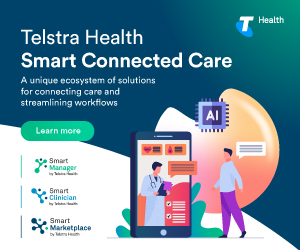Raising awareness for Crazy Socks for Docs 2019 with our Doctors Support Guide
Held on the first Friday of June, Crazy Socks for Docs was founded by Dr Geoff Toogood to help normalise the conversations around mental health, depression and anxiety amongst health professionals around the world.
In order to show our support and help raise awareness, MedicalDirector has launched this new Doctors Support Guide to deep dive into why mental health for doctors is such a pressing issue. It uncovers a range of practical tips and strategies to help support better mental health within the health industry.
The shocking rise of doctor burnout and depression
Doctors and pharmacists are becoming more prone to mental health problems than any other profession, and the stress is starting to take its toll.
In Australia, a special report by Insight in 2017 investigated that among doctors, suicide rates are disproportionately high and mental illness is common.
In the UK, A report in the British Medical Journal in 2011 found that a third of doctors have a mental health disorder. And a Royal College of Physicians’ survey of junior doctors last year found that 70% worked on a rota that was permanently under-staffed, 80% felt their work put them under excessive stress, and a quarter felt it had a serious impact on their mental health.
Meanwhile a recent report found more than a thousand British GPs have sought professional help from the NHS GP Health Service since it was set up in 2017, with most cases involving stress, anxiety and depression and about 2% addiction.
In the US, a study by MedScape of 15,000 physicians from 29 specialties found 42 per cent were burnt out and 12 per cent reported colloquial depression. Female doctors seemed slightly more likely to experience burnout, with forty-eight percent of women physicians reporting it compared to 38 percent of male physicians.
Moral injury versus doctor burnout
In a recent video, healthcare commentator Dr Z claimed we need to stop talking about ‘doctor burnout’ and focus more on the concept of ‘Moral Injury.’
According to Dr Z, moral injury arises when healthcare professionals have certain values when they enter the profession, and then face a range of onsite pressures and traumatic experiences that knocks or ‘injures’ their morals and values. For instance, how a patient’s insurance or socio-economic status, can affect the level of care a health professional can provide a patient. As a result, he argues healthcare professionals realise they can’t deliver what they thought they would in terms of ideal patient-centric health care, which leaves them feeling disillusioned and ‘morally injured’.
It is this phenomenon, he says, that’s often misconstrued as ‘burnout’, which is why he argues we need to focus more on addressing moral injury within the industry, and stop confusing it with the concept burnout.
But according to MedicalDirector’s Chief Medical Officer and GP, Dr Middleton, moral injury is just one of many of the things healthcare professionals experience and it forms part of a wider ambit of personal, emotional and psychological challenges that we can go through if we don’t feel supported.
“Yes, we can feel moral injury, but we can also experience fatigue, depression, stress, anxiety – and burnout,” she explains. “Expectations as a health professional in what we hope to achieve, how we envision what ‘ideal’ healthcare looks like from those early years as a student, and the reality of the day-to-day challenges of patient care, can leave us feeling disillusioned. Unsupported, it can wear us down mentally and physically, and more often than not, it’s a daily struggle.”
The issue is compounded by the fact that most doctors are high achievers or type A personalities, so when they are not achieving a certain standard or meeting their own expectations of success, they can quickly feel like failures, Dr Middleton says.
“Every day, we go home feeling we haven’t reached our potential in achieving our ‘ideal’ standard of health care, if we’re working in a system that doesn’t support that,” she adds. “From the very early years, we’re expected to work at a very high level – and put in extremely long hours. If this is against a backdrop of administrative inefficiencies and lack of peer support, it’s no wonder that over time, this ends up eroding away at us, impacting our mental and physical health.”
Moving away from ‘mandatory reporting’
Compounding the issue of mental health further is the concept of mandatory reporting. According to Dr Middleton, one of the dangers of mandatory reporting of doctors seeking help for mental health is that it will deter doctors to get the help they really need. Doctors who would otherwise seek help, will fear their treating doctor could report them as a risk to patients.
“On top of this, the RACGP’s concern with this legislation is that it puts too much pressure on treating clinicians to decide what issues are significant,” she says. “If this law passes, treating clinicians may be forced to report things that perhaps do not even need to be reported.”
“Any situation that discourages medical practitioners from seeking vital help is a bad outcome – not only for the doctor, but also for their patients,” she adds. “Doctors are human beings and have the right and expectation to receive treatment like any other professional, without fear of prejudice. No other profession is subject to these laws – not even those who have public safety in their hands.”
Identify the signs
The World Health Organisation has now declared “burnout” to be an occupational phenomenon that undermines how well people perform at work. It lists burnout in its latest International Classification of Diseases (ICD-11), defining it as a “syndrome conceptualised as resulting from chronic workplace stress that has not been successfully managed”.
Signs of mental health, burnout and depression to look out for, according to the Royal College of Australasian of Physicians, include:
- Emotional exhaustion
- Cynicism
- Perceived clinical ineffectiveness
- Sense of depersonalisation in relationships with co-workers, patients or both.
“I know what it’s like to really feel under the pump, you’re running over time, the nurses are calling you, you have a waiting room full of people and an endless amount of admin to catch up on,” Dr Middleton says. “It can be really stressful and very hard to just calm down when you feel there is so much against you as a GP.”
Identify the stressors
According to Dr Middleton, in order to help curb burnout, taking the time to identify the key workplace stressors can help you start prioritising areas of your working day.
“GPs spend at least six hours a week on admin alone,” Dr. Middleton says. “There’s constantly some paperwork that needs filling in and I feel that instead of getting easier every year it is getting worse. And when you’ve done a back to back day of seeing patients, then you have to fit in hours of admin work, it can become very frustrating, tiring and stressful.”
Some common workplace conditions that can lead to not being able to ‘switch off’ and lead to a high-stress medical practice environment include:
- Lack of collaboration and communication within your practice
- Inefficient or outdated practice management workflow systems
- Slow/outdated operating systems or practice management software
- Patient no-shows or difficulty staying on top of busy appointment schedules
- Complex billing, insurance requests and payment processing
- Inadequate resources
“We all strive for that utopian moment where we’re feeling 100% present with our patients and not feeling rushed or stressed, but in reality, it’s easier said than done, because there can be so many pain points to the daily workflow,” Dr Middleton adds. “But in terms of what works, it’s not necessarily a one size fits all solution. It’s a hard one to tackle because we’re all so busy, and there’s so much pressure to see all your patients.”
Be proactive in managing stress
Even if certain pressures are out your control, there can be even small, incremental changes you can implement to mitigate and manage stress.
According to Dr Middleton, while there’s a lot of buzz around doctors under stress, and putting a lot of pressure on themselves, she feels that implementing small, practical measures can make a big change to your daily workflow.
“It’s not just the patient load, but all the admin work that goes with it than can be difficult to manage and squeeze into the working day,” she explains.
For instance, Dr Middleton finishes a few hours early every Wednesday, so she has time to catch up on all her administrative tasks.
“If I didn’t make this small change to my workflow, I’d be working from home most evenings to catch up through remote access,” she says. “Now over time, that’s not healthy.”
How technology can help curb workload stress
The role of technology in all of this is to make life easier for doctors, not harder, so doctors can focus on their patients, and not their paperwork. With the right systems and process in place, we can efficiently manage our electronic medical records and clinical notes, streamline our workflow and ease the administrative burden on ourselves and our team.
“We can re-ignite closer teamwork and real-time collaboration, by leveraging the power of interoperability and the cloud,” Dr Middleton explains. “Most importantly, we can and offer more flexible and personalised patient care and help achieve what our vision for ‘ideal’ healthcare looks like now, and for the future.”
Some ways technology can help curb workload stress include:
- Automating mundane tasks, to enable practice staff to tend to more complex matters
- Integrate EFTPOS transactions for fuss-free billing
- Using the latest clinical and practice management software to streamline workflow
- Updating all practice management software so it is running quickly and efficiently
Take a real mental break
“For a number of reasons, there is increased the pressure on GPs to see as many patients as possible in the working day, with little or no time to complete admin during these hours,” Dr Middleton says. “This has ultimately extended the working day drastically for GPs, and negatively impacted the work-life balance for the practitioner.”
In order to feel more recharged, refocused and re-energised, Dr Middleton suggests taking the time to take a real mental break from being a practitioner. For her, this means not turning on her computer on weekends for work-related tasks, and spending quality time with family. Regular breaks and holidays are also key.
“It’s so important to take a complete break from the working week,” she adds. “And have regular holidays planned, so you always have something to look forward to. Even regular weekend getaways can give you that down time to help you recharge and be more energised to see your patients in the week.”
The art of mindfulness
According to Dr Middleton, there is a lot of research around the benefit of mindfulness, and just taking the time to try and be in the present moment.
“I know of studies that have gone into schools and workplaces, and done extensive research on the benefits of mindfulness and its positive impact on behavioural changes from childhood into adulthood,” she says. “I know it sounds like a bit of a buzzword, but there is actually a lot to it, especially when it comes to tackling the everyday stresses of being a doctor.”
For Dr Middleton, simple breathing exercises between patients really help bring her get back into the moment and to feel more focused for her next patient.
“I’ve really started doing this more regularly at the start of the day, between patients, or when I’m feeling rushed,” she says. “It’s about just taking that moment to close your eyes, breathe and be in the moment.” “It’s also a chance to tell myself, I’m doing the best I can!”
GP’s working part-time
Dr Middleton, who splits her time as a GP in Wollongong and MedicalDirector’s Chief Medical Advisor, says she’s part of a growing pool of doctors who are now going part-time in order to gain more work-life balance.
“I was on a GP Facebook forum recently, where someone posted a question about how many GPs actually work full-time,” she says. “It was interesting because it was almost universal that no GP was working five days a week, and we were all doing other things as well with our time.”
“Most people were either mixing it up between practices, or between professional roles such as medical educator, advisory or supervisory roles, and doing perhaps three or four days a week in general practice to try and reduce their stress levels,” she adds. “It really reflects how doctors are recognising that it’s a hard job to do full-time because it’s just too much, too stressful and simply too hard to keep up.”
Have the right support structure
It’s also important we start giving health professionals the right support structures to pave the way in achieving their vision for ‘ideal’ healthcare now, and for the future, Dr Middleton says.
Already, we’re seeing the appointments of ‘Wellness Officers’, such as Australia’s first Chief Medical Wellness Officer, Dr Bethan Richards from Sydney Local Health District, whose role is to offer a cultural and systematic change in the hospital system, with the aim of reducing stress and burnout among junior and senior doctors. It’s the nation’s first wellness program for doctors, based on the world-leading Stanford University model.
“While this a fantastic move, it’s still very much an industry exception and not yet the ‘norm’, Dr Middleton says. “This demonstrates we still have a long way to go in order to reach the appropriate level of support the wider health community needs.”
“Moving forward, there needs to be more recognition that medical professionals are at high risk of mental health issues. This recognition needs to come within the industry just as much as outside, and we need measures put in place to support doctors when they need it most.”
How to participate in Socks for Docs
Crazy Socks for Docs will be held this year on Friday 7th of June
To take part, simply take a picture of you or your colleagues in your crazy coloured socks and share on your social media channels, with the hashtag #crazysocks4docs.
More details are here.
To find out more about Socks for Docs visit: https://www.crazysocks4docs.com.au/









